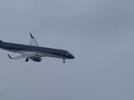Sriwijaya B733 at Yogyakarta on Dec 20th 2011, runway excursion
Indonesia's NTSC have released their final report concluding the probable cause of the accident was:
Unsuccessful to recognize the two critical elements, namely fixation and complacency affected pilot decision to land the aircraft while the approach was not meet the criteria of stabilized approach.
The NTSC reported that the aircraft had joined a holding over Yogyakarta VOR (JOG) due to weather, the weather however had deteriorated forcing the airport authority to close the aerodrome and the crew of SJ-230 to divert to Surabaya (Indonesia) where the aircraft landed safely.
The aircraft was refueled, the weather at Yogyakarta improved, so that the aircraft departed Surabaya again after about 40 minutes on the ground. The aircraft arrived at Yogyakarta as fifth in sequence of 7 arriving aircraft. The captain had put approach charts on the left writing pad, the top chart was the ILS runway 10 chart for Surabaya, the second page was the ILS approach runway 09 Yogyakarta and the third page was the VOR/DME runway 09 Yogyakarta, the bottom page was the standard arrival procedure runway 09 Yogyakarta.
The aircraft approached Yogyakarta for the VOR/DME approach runway 09, passed JOG VOR at 2700 feet MSL at a speed of 203 knots over ground (according to radar data), at about 1200 feet MSL the crew reported the runway in sight, the aircraft was handed off to tower and received landing clearance by tower together with the information of light rain, the runway being wet and the winds were calm. The captain (58, ATPL, 29,801 hours total, no time on type provided), pilot flying, recognized the aircraft was not aligned with the extended runway center line and all four VASIs showed white indicating the aircraft was above glidepath, the captain disconnected autopilot and autothrottle and continued manually to correct the trajectory and profile. The captain's left course indicator was set to 091 degrees, the right hand course indicator to 084 degrees, both pointers had been connected to the ADF. Several EGPWS warnings "Pull Up!" sounded, the captain selected autobrakes to setting 4. There were no call outs by the first officer (28, CPL, 562 hours total, no time on type provided) although required.
On short final the captain managed to establish the aircraft on the normal vertical profile, the indicated airspeed was 158 knots. The aircraft touched down at 156 KIAS (Vref+18, Vref=138 KIAS), radar data showed a speed over ground of 169 knots upon touch down. Spoilers extended automatically, the aircraft however bounced. Brakes pressure reached close to maximum shortly after touchdown and continued to be near maximum until stand still. The flaps extended to 40 degrees after touchdown.
After touch down the captain engaged thrust reversers, the crew however did not feel any deceleration. When the captain recognized they would not be able to stop on the runway, he steered the aircraft to the left. The aircraft came to a stop 75 meters past the runway end and 54 meters to the left of the left of the runway center line, the nose and right main gear legs had collapsed and the aircraft's belly had received substantial damage as result as well. Two runway lights and one taxiway signboard were damaged.
After the aircraft came to a stop, the captain commanded "Brace! Brace!" via the passenger announcement system (PA), however nothing was heard in the cabin. The crew subsequently ran the "Emergency on Ground" procedure.
Cabin crew noticed that the cabin lighting had changed to evacuation lighting and observed black smoke from the left hand engine. The flight attendants therefore initiated the emergency evacuation opening all doors. Some passengers also opened the overwing emergency exits.
An elderly passenger in seat row 2 was pushed by other passengers, cabin crew intervened and held other passengers back while assisting the elderly passenger to evacuate. Another passenger transported on a stretcher was evacuated by ground rescue personnel. Six passengers received minor injuries as result of the evacuation.
The NTSC reported that all navigation aids were found working properly and had no role in the accident. Communication between ground and aircraft was generally good and had no role into the accident, too.
The NTSC reported that the cockpit voice recorder revealed that there had been no checklist reading and no approach briefing. There had been a discussion between the pilots regarding the VOR/DME approach pattern, particularly about inbound courses and altitudes to be flown at specific stages. The captain asked "how many miles are we now" and the automation was disengaged immediately after the call "runway in sight" was done prior to the EGPWS calling "one thousand". The EGPWS activated two times with "Sink Rate" and "Pull Up!" at 500 feet, after the call "Two hundred" the EGPWS issued again "Sink Rate!" and "Pull Up!" warnings, that ended prior to the call "ten".
The NTSC analyzed that although after passing the VOR the inbound course was 084 degrees the aircraft continued on 090 degrees which brought it to the right of the extended runway centerline. After the runway got in sight the pilot flying attempted to correct by rolling the aircraft left to about 25 degrees of bank. Several EGPWS warnings "Sink Rate" and "Pull Up" occurred, the rate of descent increased up to 2040 fpm, even between 200 and 10 feet AGL.
The NTSC stated: "This profile indicated that the aircraft was higher than the required profile. The pilot tried to correct the profile by increasing the rate of descend. This manoeuvre has a consequence of increase in aircraft speed. These situations indicated that the aircraft was not on profile for approach related to the path (direction) and profile (altitude) compare to the VOR DME approach procedure for runway 09 Yogyakarta. This might due to that the PF did not perform approach briefing and was not ready with the approach page on the writing pad for review."
The NTSC analyzed that spoilers fully extended and brakes activated immediately after touchdown, the brakes operated normally throughout the roll out.
The flaps extended to 40 degrees only after touch down due to the flaps relief system, that prevented extension to 40 degrees due to flap overspeed.
The NTSC concluded the analysis: "These situation indicated that the approach was not meet the 9 criteria of stabilize approach according to the Flight Safety Foundation as stated in the Boeing Flight Crew Training Manual (FCTM). The aircraft speed was 20 Kt above the target. The aircraft path was deviate and higher from the published approach path. The pilot corrected the final track and approach path by lower the aircraft nose down and rate of descend up to 2040 ft per minute. However, this action has resulted in high aircraft speed."
The NTSC bitterly complained about cockpit discipline. Not only were approach briefing and checklist reading not conducted, the captain asked for the aircraft position, the relevant approach charts were not readily available for review during the approach, the course indicators were connected to the ADF with no purpose, the pilot flying being unfamiliar with the VOR/DME runway 09 approach procedure. The pilot flying, other than required by the manuals to immediately react to the first EGPWS warning, ignored the EGPWS warnings. Final sentence by the NTSC: "According to the descriptions above, the procedures were not well implemented."
With respect to human factors the NTSC analysed that the lack of briefing, checklist reading, cockpit preparation for the approach were "the symptoms of fixation which is one of the critical elements of the situational awareness."
The NTSC continued: "The pilot kept on landing while the approach was not in the stabilize approach criteria. This symptom is an indication of complacency, which is one of the critical elements of
the situational awareness. There was a passenger expressed his disappointment of the pilot decision to divert to Surabaya. This event was suspected to affect the pilot decision."
The NTSB also analyzed: "Within the preceding six months, the PIC has flight hours more than 100 hours every month. This condition may lead to pilot fatigue."
With respect to crew resource management the NTSC stated as summarizing analysis: "These conditions could be concluded that the CRM was not well implemented."
The operator took a good number of safety actions following the accident.
The NTSC released safety recommendations to Indonesia's Directorate General of Civil Aviation and the airline to ensure fatigue levels of flight crew remain acceptable and to ensure proper training of flight crew.
Nose gear (Photo: NTSC):
Right main gear (Photo: NTSC):
Ground tracks (Photo: NTSC):
Trajectory (Graphics: NTSC):
VOR/DME runway 09 approach chart (Graphics: NTSC/AIP Indonesia):
http://avherald.com/h?article=447f70f9/0000














Komentarze